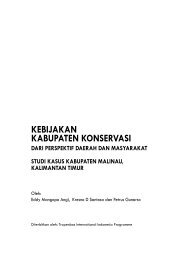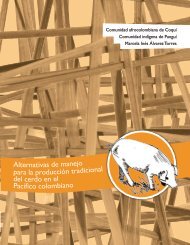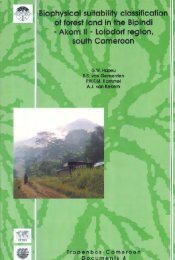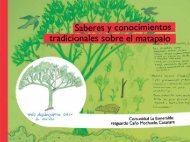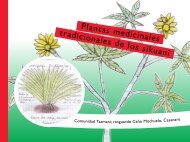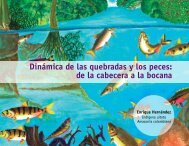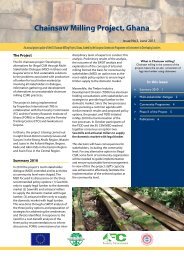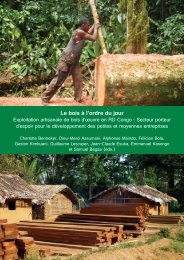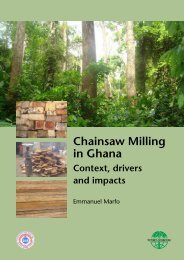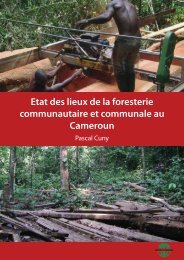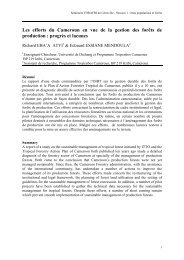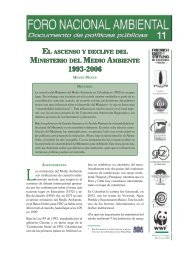Download the publication - Tropenbos International
Download the publication - Tropenbos International
Download the publication - Tropenbos International
You also want an ePaper? Increase the reach of your titles
YUMPU automatically turns print PDFs into web optimized ePapers that Google loves.
Central African tropical rain forest structure and composition<br />
Altitude<br />
Altitude also had a positive influence on <strong>the</strong> general vegetation patterns and species<br />
composition in <strong>the</strong> area (Figure 2.5). It is worth mentioning that <strong>the</strong> effect of altitude<br />
on <strong>the</strong> vegetation is less pronounced in <strong>the</strong> Campo-Ma’an area than in o<strong>the</strong>rs<br />
mountainous areas in Cameroon. This is partly due to <strong>the</strong> fact that Campo-Ma’an is<br />
not a mountain and <strong>the</strong> hills found here are low (up to 1100 m above sea level) and<br />
do not show a clear altitudinal gradient in <strong>the</strong> vegetation from sea level to <strong>the</strong> top.<br />
On <strong>the</strong>se hills <strong>the</strong> forest composition was almost <strong>the</strong> same on both sides of <strong>the</strong> slope.<br />
Generally, on high mountains, <strong>the</strong> number of species tends to decrease with<br />
increasing altitude. But in <strong>the</strong> Campo-Ma’an area, <strong>the</strong>re was ra<strong>the</strong>r a relative<br />
increase of species richness with increasing altitude. High altitude forest appeared to<br />
be relatively more species-rich than <strong>the</strong> lowland and coastal forests. In <strong>the</strong><br />
submontane forest, more than 93% of <strong>the</strong> plots had at least 100 species/0.1 ha.<br />
Fur<strong>the</strong>rmore, <strong>the</strong> structure and composition of <strong>the</strong> forest, as well as <strong>the</strong> physiognomy<br />
of <strong>the</strong> species change progressively as one moves from <strong>the</strong> lowland to <strong>the</strong><br />
submontane forest. In <strong>the</strong> lowland forest, trees were taller (up to 50 m) and a<br />
considerable number of emergent and canopy trees have large buttresses. Many<br />
small trees and shrubs bear <strong>the</strong>ir flowers and fruits directly on <strong>the</strong> trunk or large<br />
branches. The submontane forest was lower (25-35 m) than <strong>the</strong> lowland forest and<br />
between 900-1100 m many trees were covered with bryophytes and vascular<br />
epiphytes. Fur<strong>the</strong>rmore, special physiognomic features characteristic of <strong>the</strong> lowland<br />
forest such as large woody lianas, buttressing and cauliflory were less common.<br />
Soils<br />
The relationships between soil characteristics and <strong>the</strong> vegetation types was less clear<br />
than o<strong>the</strong>r environmental variables such as rainfall, proximity to <strong>the</strong> sea and altitude,<br />
though soil type showed highest correlation with <strong>the</strong> third axis of <strong>the</strong> CCA result.<br />
Mangroves and swampy forests on hydric soils with poor drainage conditions have<br />
low nutrient concentrations and are species-poor. This must stem partly from <strong>the</strong><br />
fact that, in exception to mangrove and swamps that are characterised by a<br />
distinctive edaphic condition, soils in <strong>the</strong> research area are well drained, strongly<br />
wea<strong>the</strong>red, and acid with pH (H2O) values generally around 4. However, soil type<br />
and drainage were correlated with plots recorded in mangrove and swamps forests<br />
(Figure 2.3). Gartlan et al. (1986) and Newbery et al. (1996) undertook similar<br />
analyses in Korup National Park and <strong>the</strong> Douala-Edea Forest Reserve in Cameroon<br />
and found that <strong>the</strong> main environmental factors affecting vegetation were rainfall,<br />
altitude, slope, drainage, and potassium and phosphorus concentrations in <strong>the</strong> soil.<br />
They argued that rainfall and seasonality are likely to lead to stronger distributional<br />
gradients than soil nutrients in equatorial Africa rain forests. Although we did not<br />
carry out soil nutrient analyses, we found that in addition to rainfall, proximity to sea<br />
and altitude, human disturbance, drainage and soil type are <strong>the</strong> most important<br />
characteristics influencing <strong>the</strong> vegetation types in <strong>the</strong> Campo-Ma’an area. However,<br />
it is noteworthy to mention that many of <strong>the</strong> present-day distributions of plant<br />
species in <strong>the</strong> tropical Africa region are also dependent on <strong>the</strong> Pleistocene history<br />
and <strong>the</strong> continuing influence of Quaternary glacial and inter-glacial periods<br />
(Hamilton, 1982; White, 1983; Maley 1987, 1989, 1993, 1996 & 2001; Sosef, 1994<br />
& 1996).<br />
37



